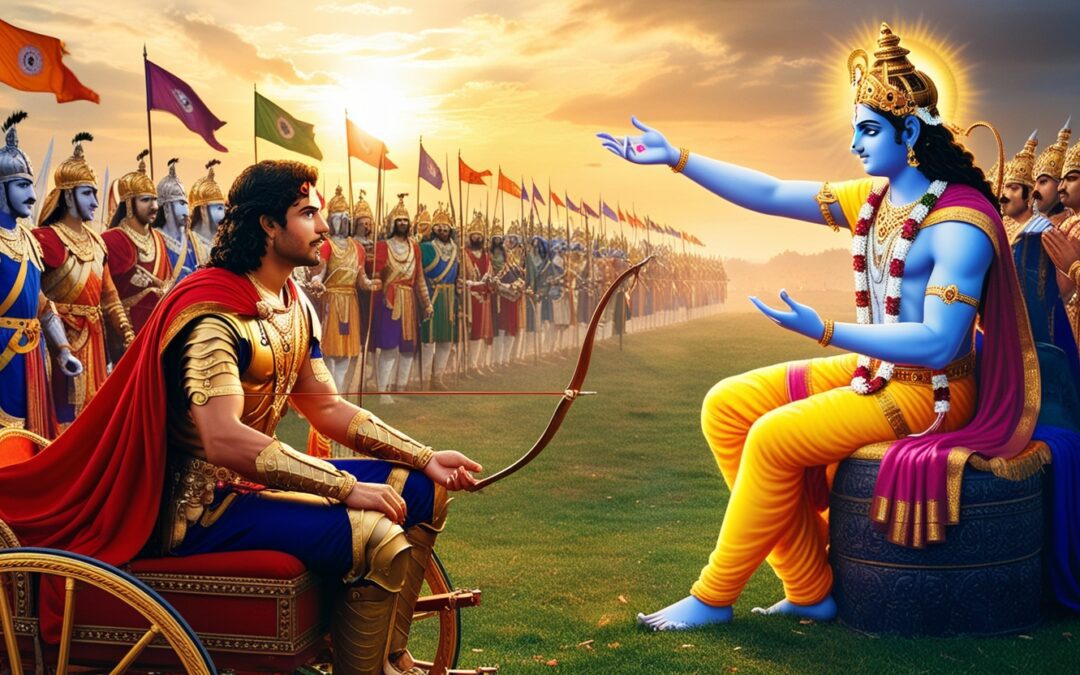10 Key Teachings from the Bhagavad Gita
The Bhagavad Gita, often referred to as the Song of God, is one of the most revered scriptures in Hindu philosophy. It is a dialogue between Lord Krishna and Arjuna, set on the battlefield of Kurukshetra, just before the great war of the Mahabharata. Arjuna, the mighty warrior, is overcome with doubt and moral confusion about fighting his own relatives and teachers. Krishna, serving as his charioteer and divine guide, imparts profound spiritual wisdom that addresses life’s deepest questions.
The Bhagavad Gita is not just a religious text; it is a manual for life, offering guidance on how to navigate challenges, perform one’s duty, and attain self-realization. Here, we explore ten key teachings from the Bhagavad Gita that continue to inspire millions across the world.
1. Do Your Duty Without Attachment to Results (Karma Yoga)
One of the most famous teachings of the Bhagavad Gita is the concept of Karma Yoga—selfless action. Lord Krishna advises Arjuna:
“Karmanye vadhikaraste, ma phaleshu kadachana” (Bhagavad Gita 2.47)
Meaning: You have the right to perform your duty, but never to the fruits of your actions.
This means we should focus on our responsibilities and perform them with full dedication, without obsessing over success or failure. In today’s world, where stress and anxiety often stem from expectations, this teaching encourages us to work sincerely and let go of attachment to outcomes.
2. The Immortality of the Soul (Atman)
Krishna explains to Arjuna that the soul (Atman) is eternal and beyond birth and death:
“For the soul, there is neither birth nor death at any time. It does not come into being and will not cease to be.” (Bhagavad Gita 2.20)
This teaching reminds us that we are not just physical bodies but divine souls, unaffected by temporary joys and sorrows. Realizing this truth helps one develop detachment from material worries and a greater sense of inner peace.
3. Control Over Desires and Mind (Dhyana Yoga)
Krishna highlights the importance of mind control and self-discipline:
“For one who has conquered the mind, the mind is the best of friends; but for one who has failed to do so, the mind will remain the greatest enemy.” (Bhagavad Gita 6.6)
Our thoughts shape our actions, and an uncontrolled mind can lead to suffering. Through meditation (dhyana yoga) and self-discipline, one can attain clarity, peace, and wisdom.
Also read: The Mahabharata Lessons in Dharma and Ethics
4. The Three Gunas: Sattva, Rajas, and Tamas
Krishna explains that human nature is influenced by three gunas (qualities):
- Sattva (Purity, Wisdom, Goodness): Leads to peace, knowledge, and harmony.
- Rajas (Passion, Activity, Restlessness): Fuels ambition, desires, and action.
- Tamas (Ignorance, Inertia, Darkness): Causes laziness, confusion, and negativity.
By cultivating sattva, one can rise above material bondage and attain spiritual enlightenment.
5. Surrender to God (Bhakti Yoga)
Krishna emphasizes the path of devotion (bhakti yoga):
“Abandon all varieties of dharma and simply surrender unto Me. I shall deliver you from all sinful reactions. Do not fear.” (Bhagavad Gita 18.66)
This verse highlights that true liberation comes from complete faith in God. By surrendering with love and trust, one experiences divine grace and freedom from worries.
6. Balance in Life (The Middle Path)
Krishna advises a life of balance and moderation:
“He who is temperate in eating, sleeping, working, and recreation can mitigate all sorrows by practicing yoga.” (Bhagavad Gita 6.17)
This teaching stresses the importance of avoiding extremes—neither excessive indulgence nor extreme renunciation. A balanced life leads to good health, mental peace, and spiritual growth.
7. The Power of Faith and Determination
Krishna explains that faith (shraddha) shapes one’s destiny:
“A person is what their faith is. Whatever one has faith in, that indeed they become.” (Bhagavad Gita 17.3)
This means our beliefs and convictions influence our actions and experiences. Cultivating positive faith leads to inner strength and spiritual progress.
8. The Concept of Dharma (Righteous Duty)
Krishna tells Arjuna:
“It is better to fail in one’s own dharma than to succeed in the dharma of another.” (Bhagavad Gita 3.35)
Each person has a unique duty (swadharma) based on their role in life. Fulfilling one’s responsibilities, whether as a student, parent, worker, or seeker, is the path to self-realization. Avoiding one’s duty leads to inner conflict and dissatisfaction.
Also read: Reincarnation in Hinduism: Understanding the Cycle of Birth, Death, and Rebirth
9. Fearlessness and Inner Strength
Krishna teaches that one should be fearless and unwavering in righteousness:
“The one who neither rejoices nor hates, neither grieves nor desires, who has renounced both good and evil, such a person is dear to Me.” (Bhagavad Gita 12.17)
Fear arises from attachment and ignorance. By developing detachment, wisdom, and faith, one can live with courage and inner strength.
10. The Ultimate Goal: Liberation (Moksha)
The Bhagavad Gita teaches that the highest purpose of human life is moksha (liberation from the cycle of birth and death).
“When a person rises above the influence of the three gunas, they attain immortality and become fit for union with the Supreme.” (Bhagavad Gita 14.20)
This means transcending material desires, attachments, and illusions to realize one’s divine nature.
Applying the Teachings in Daily Life
The wisdom of the Bhagavad Gita is timeless. Whether facing personal dilemmas, workplace stress, or emotional turmoil, its teachings offer clarity and direction. By practicing selfless action, devotion, self-discipline, and wisdom, one can live a fulfilled and enlightened life.
The Bhagavad Gita is not just a scripture—it is a guide to living with purpose, peace, and spiritual wisdom. By imbibing its teachings, one can rise above suffering and realize their highest potential.
Let us reflect on these divine lessons and strive to apply them in our daily lives, leading us towards a path of righteousness, inner peace, and ultimate liberation.
Support us by purchasing from our Affiliate Links:
Thirteen Months In The Himalayas


Trackbacks/Pingbacks